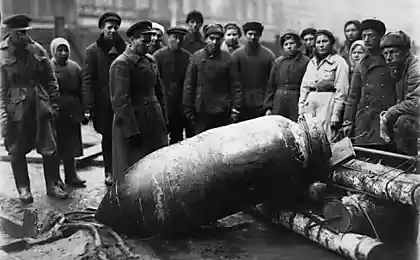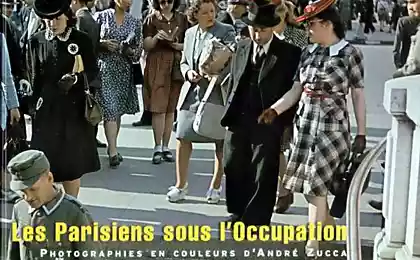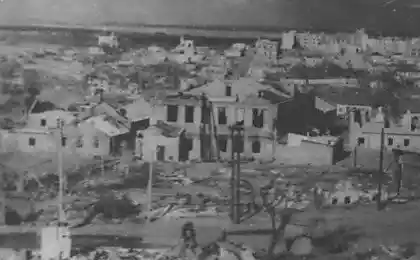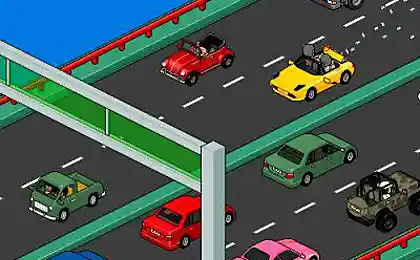7588
1942-43 Stalingrad - Volgograd in 2013 (65 photos)
Sergey Larenkov continues to work on a series of photographs in which connects contemporary photographs with pictures taken during the Second World War. At this time, the lens Sergei Volgograd / Stalingrad.

So, the summer of 1942. After a disaster, the Red Army near Kharkov in the front line to Don steppes exposed, and overcoming a few desperate resistance of the Soviet troops, the Wehrmacht launched an offensive to the Volga and the Caucasus. August 23 the Germans reached Stalingrad, on the same day the worst airstrike German bombers, who turned the once flourishing city in ruins solid. Within a few hours, killing more than 40 thousand inhabitants.
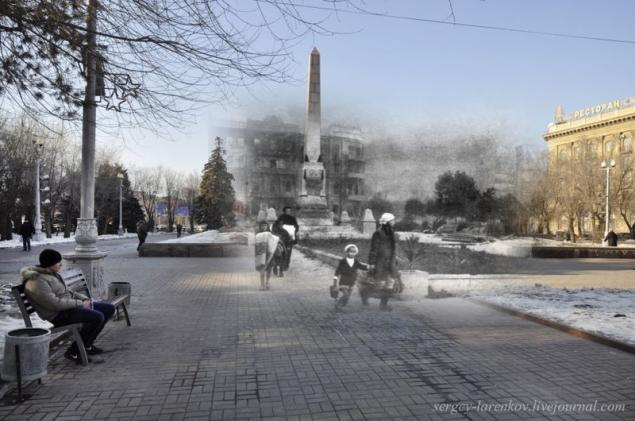
Obelisk on Fallen Fighters Square.
The Germans at Kursk Street. (St. Port Said) to the former school building (now the Engineering and Technical Lyceum) later was attached wing with a gym.
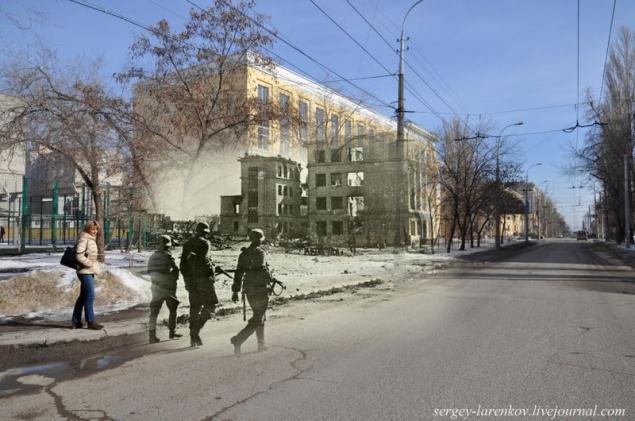
German guns in Musical Theatre. The theater building was rebuilt after the war, but greatly changed

Musical theater.
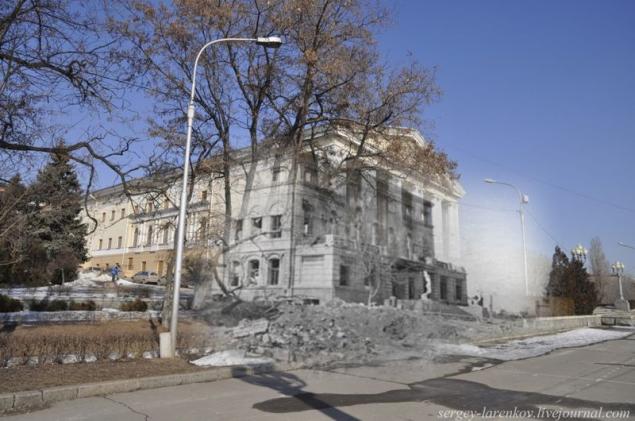
Paulus at Stalingrad tsenre Street. Ostrovsky. On the right is one of the few surviving pre-war buildings in part, now it is the hotel Old Stalingrad.

Paulus at department stores. The same place on the other side only. Behind yet Colonel-General Paulus same Department, who will go down in history associated with his name.

The building department with Hitler's flag. The facade of the department store located in the courtyard of the new building Intourist.

The soldiers of the Wehrmacht in the Kursk Street (now st. Port Said). Building on the left (Port Said 8a) did not seem to have changed.
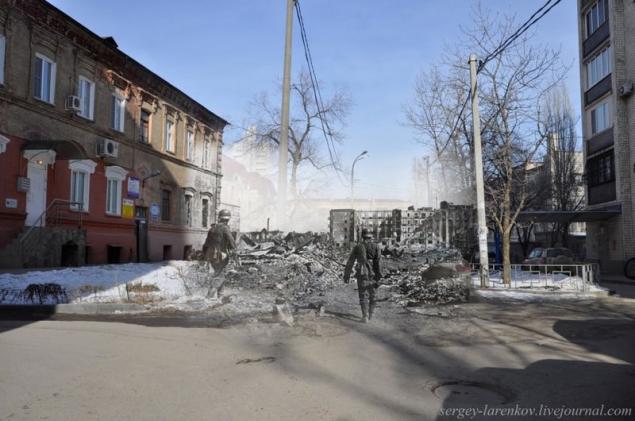
Pavlov's House became a symbol of the defense of Stalingrad. In September 1942, the assault force under the command of Sergeant Yakov Pavlov knocked the Germans out of the building. Soviet soldiers kept house, repulsing the attacks of the Nazis for two months until the liquidation of the German group. Field Marshal Paulus on the first interrogation after capture admitted that attempts to capture the house on the square of the 9th January Germany lost more of their soldiers than the conquest of France.

Pavlov's House from the area on January 9 (Lenin Square). After the war, the House of Pavlov built a colonnade. In the background you can see the mill building Gerhardt.
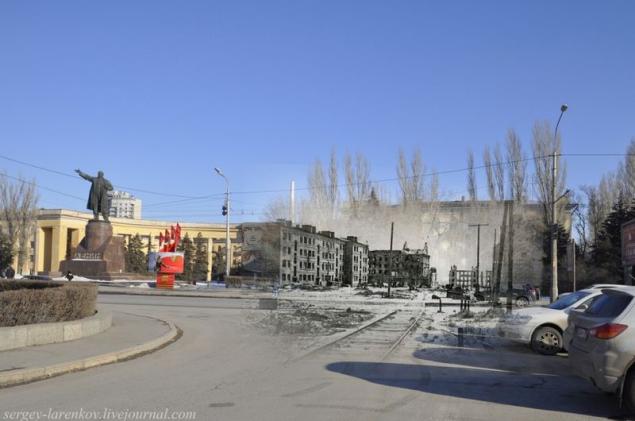
Pavlov (the hero of the famous defense "Pavlov's House") and AM Cherkasova - Brigadier 1st Brigade volunteer to restore Stalingrad talk against the backdrop of the House of Pavlov Pavlov's House became one of the first buildings in Stalingrad recovery record. Now this is an ordinary house. When I shot it, granny angrily slid the curtain.

The angle of the hotel "Most of Stalingrad" and the building department. Prior to the airstrike. Both of these buildings and that from them will be visible in many of the photos. After the war, restored the building department in the basement where the headquarters of Paulus, will be built Intourist, but we'll get to that later.

Unpreserved inscriptions on the wall of the house Pavlova.

One of unpreserved inscriptions on the wall of Pavlov. No inscriptions on the house has been preserved, but at both ends to attach monumental brick inserts.
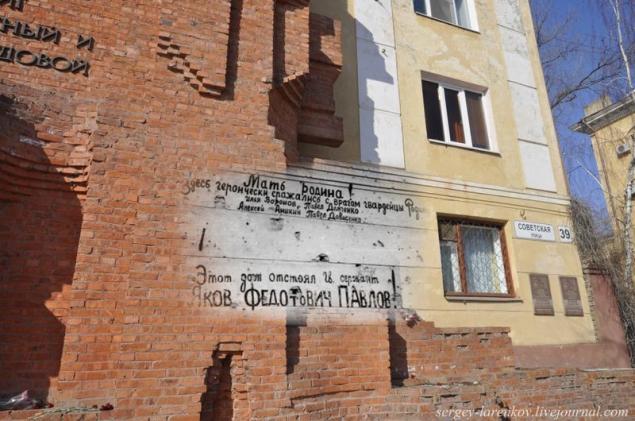
Sarepta. St. Arsenyev 6. This house is located in the southern part of the city, where German is not reached. But traces of destruction on the house allocated under modern paint.

Fight off the destroyed building of the hotel "Most of Stalingrad." There is a building already destroyed more than a photo № 05. Part of the old Tsaritsyn - Stalingrad had prewar diagonal layout of the streets, after the war, instead of them struck the streets parallel and perpendicular to the Volga. First punched Street - Street of Peace takes on the photo to the right.
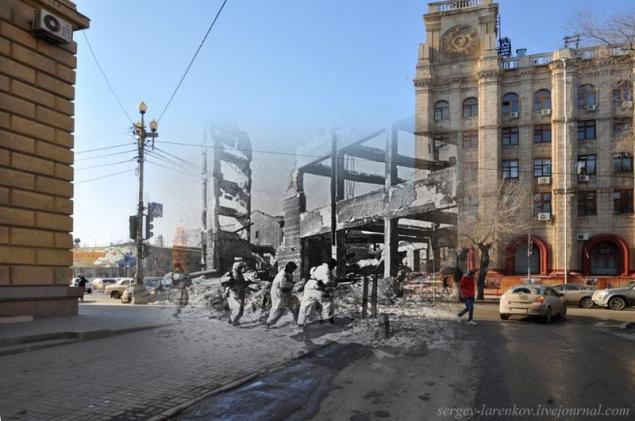
Soviet T-34 tanks at the station. Station also includes fighting was heavily damaged. After the war, in its place built a new station, bears little resemblance to the old.
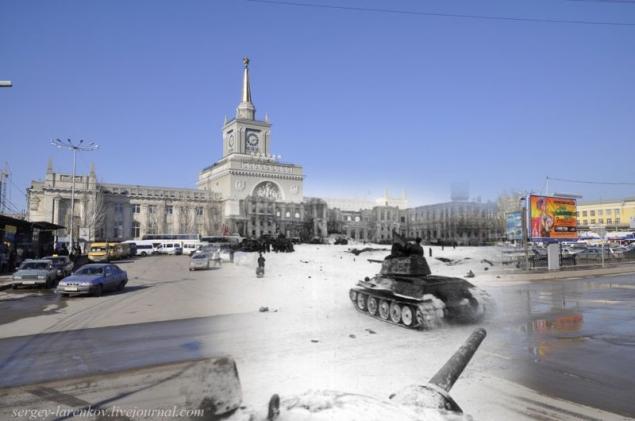
Soldiers at the Museum of Defense of Tsaritsyn at the end of the fighting. Now called Volgograd Memorial and Historical Museum, there is a very interesting exhibition dedicated to the Civil War, and white, and red. And behind the fighters is a monument to the legendary Cossack Konstantin I. Nedorubovu full of George Knight and hero of the Soviet Union. Behind you can see the station building.
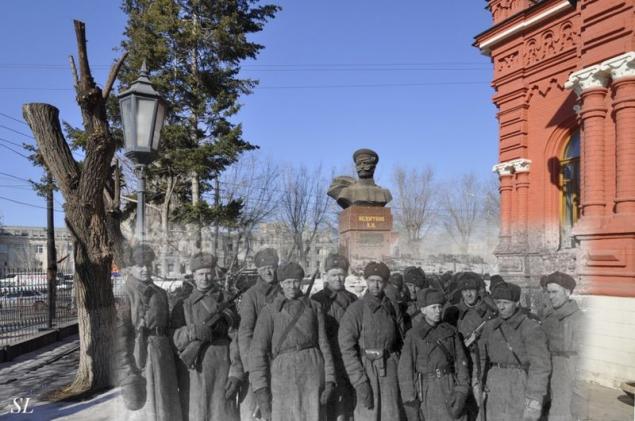
The museum building after the fighting. The museum building was severely damaged during the fighting, but was rebuilt in its present form.

Stalin monument at the Museum of Defense of Tsaritsyn and communal house.

Communal house.

The ruins of houses with communal street. Gogol.

German gun is firing positions in the elevator. Building elevator is the highest in the city, and it turned fierce fighting. Stalingrad elevator defended seamen.

Soviet soldiers on Communist Street. Left - Ruined house communal and away surviving building at Communist, 10
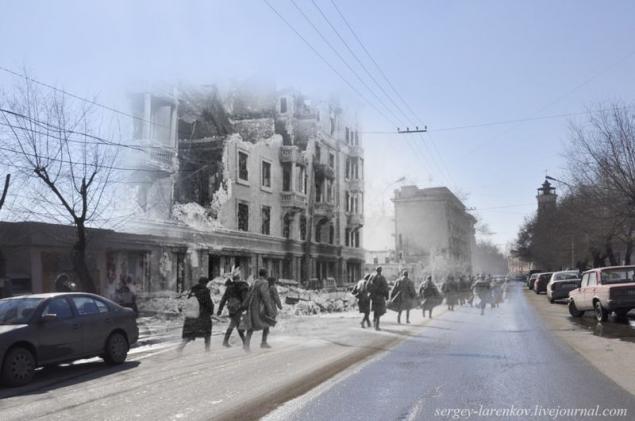
Fountain "Children's dance" at Railway Square. At the site of the fountain is now parking.
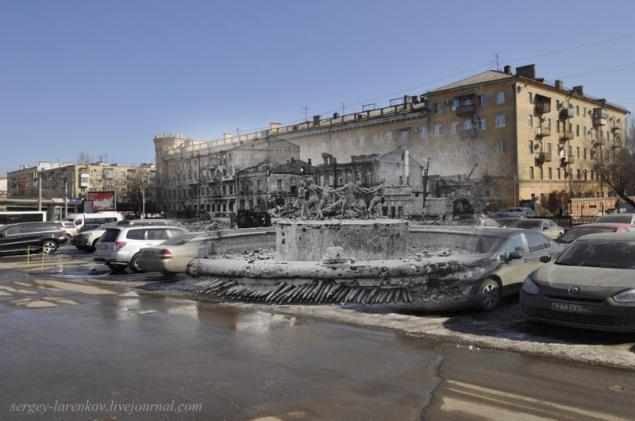
Railway Station Square. Fountain "Children's dance." This photo Emmanuel Yevzerikhin is the most famous photograph taken in Stalingrad fight.
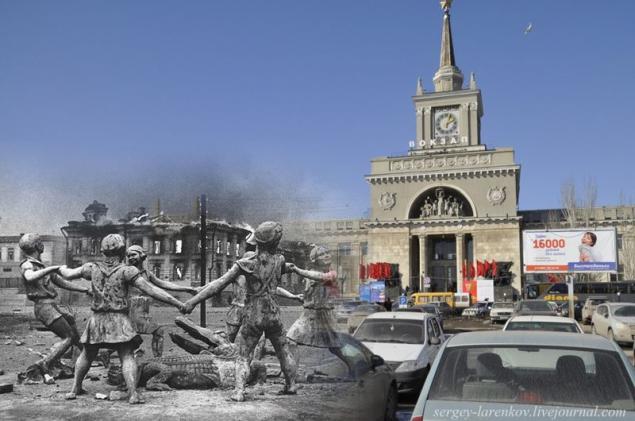
Fountain "Children's dance" on the background of the Museum of Defense. The fountain itself is a model in several cities in the Soviet Union were built exactly the same (Voronezh, Dnepropetrovsk).

Fountain "Children's dance." The fountain was rebuilt after the war, but in the 50 years analyzed as non-artistic value.

Fountain "Children's dance." Judging by the Volgograd press from time to time there is a question about the restoration of the fountain, but so far more than talk is not moved.

Dzerzhinsky Square. T-34 tank at Stalingrad Tractor Plant in front of the school №3. Exactly the same tank, and maybe this is worth here on the left as a monument.

Dug in the school yard №3. Tragic fate of the civilian population of Stalingrad. Of those who survived the bombing, many do not have time to evacuate, they had to live almost on the front line in the cellars and dugouts. On the German-occupied territory of civilians are being evicted and stolen in Germany.

T-34 tank on the Square of Fallen Fighters. Again, helped bind the building department, shines through the hotel "Intourist».

Beketovka. Paulus after the surrender before the first interrogation at the headquarters of the 64th Army. January 30 Hitler Paulus was awarded the rank of Field Marshal. Radiogram to this order has been accepted as to the headquarters of Paulus in the department store has approached the Soviet assault group. Hitler hoped that Paulus in this case prefer to shoot. However, this morning took delivery of Field Marshal captured. By 12 o'clock he was taken to the headquarters of Beketovku commander of the 64th Army, General Shumilova, where he hosted the first interrogation of Field Marshal. This is the place to find it was not so hard (harder to pass). In the distance you can see the building of the hospital, perfectly preserved since then. But upon closer inspection coincided home and on the right. Only they look older and a little rooted in the ground. 70 years all are gone.

German self-propelled guns at the Lipetsk Shturmgeshutts street.
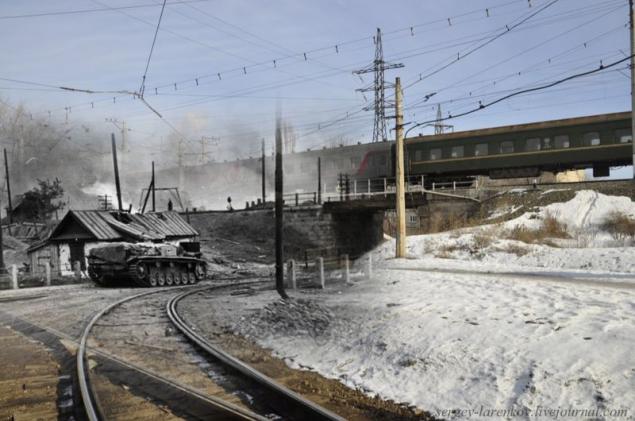
Beketovka. Staff officers Paulus after surrender. In this house the headquarters of the commander of the 64th Army, General Shumilova what states corresponding to a memorial plaque, as well as the fact that it hosted the first interrogation of a German field marshal.
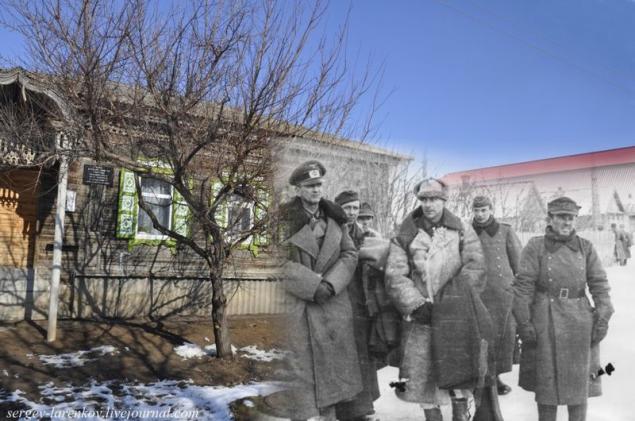
Red Army soldiers at the barricades on the Square of Fallen Fighters.

Fallen Fighters Square after the end of fighting.

Fallen Fighters Square after the end of fighting.

Area of Fallen Fighters. Surrendering the Nazis, survived the assault.

Shadows of the prisoners of the Nazis in the Square of Fallen Fighters. I think this corner of the hotel "Most of Stalingrad" is the same symbol photographic Battle of Stalingrad, as the fountain "Children's dance».

Captured Germans in the Square of the fallen fighters. In Stalingrad cauldron was captured more than 91 thousand German soldiers and officers, including 24 generals.
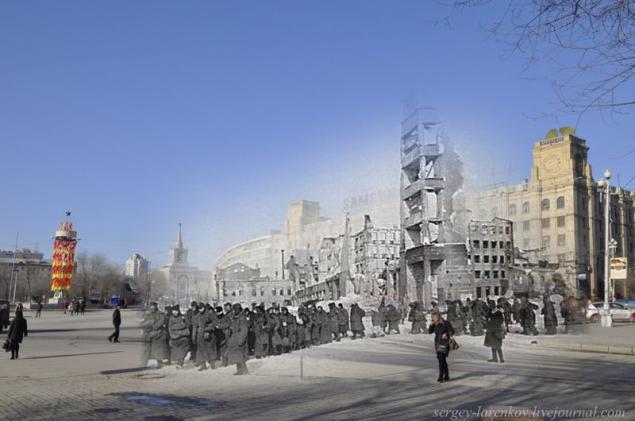
Captured Germans at the factory Red October. One of the three collapsed buildings left in Volgograd as a monument, located on the territory of the factory Red October. This two-story brick building, central laboratory. From this perspective it can be seen only the right end, the rest of the temple now covers. Well, on the collage all seen through the temple. I want to thank the Department of Public Relations factory "Red October", and personally Dametken Arshimovu and Veronica Yurkov for the operational organization of admission to the regime territory of the plant.

Captured soldiers of the German 6th Army at the elevator.
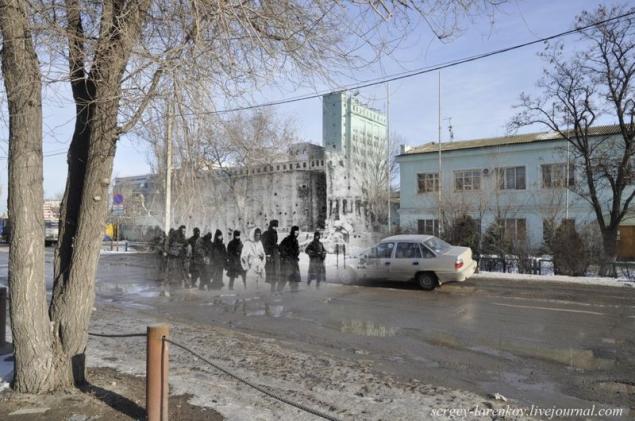
German graves at the department store.

Stalingrad 1942 - Volgograd, 2013. Street Ostrovsky. Refugee with things. Acute angle, the remainder of the hotel "Most of Stalingrad" allows a certain accuracy to calculate this place. All modern buildings built in the frame without reference to the foundation of the old, in new places.

German graves at the department store.

Captured on dismantling the ruins of the station. Return to Germany German prisoners began in 1945. Were first released disabled and the sick. By 1950, the majority of Germans who did not participate in war crimes to go home. Released the latest by 1955.

Destroyed mill Gerhardt and Panorama. It is often mistakenly referred to as the House of the mill Pavlova.

Kirch

Proletkultskaya street
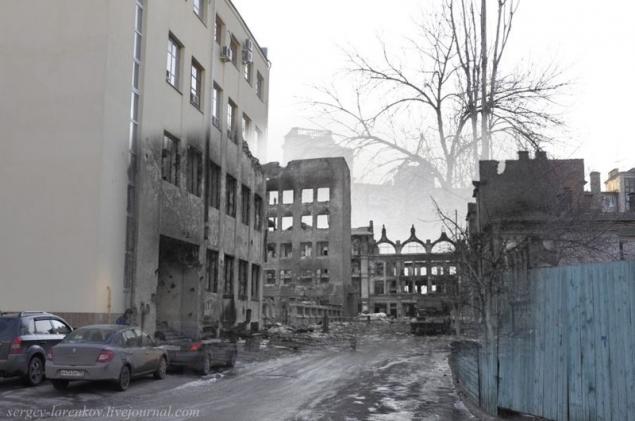
Mamaev Kurgan after fighting
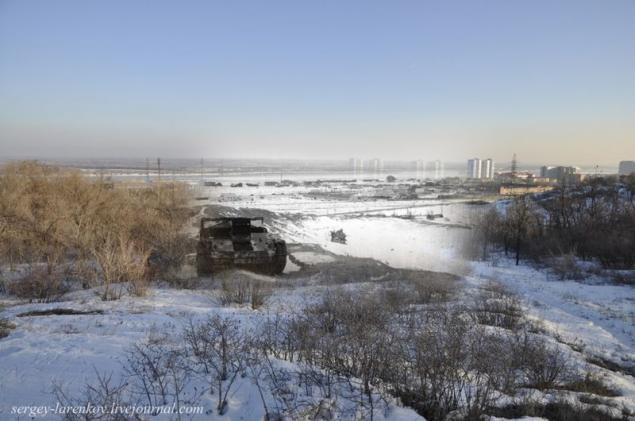
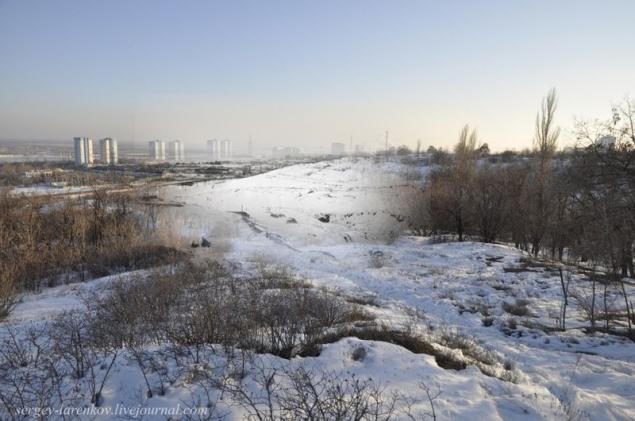
The meeting at the Square of Fallen Fighters after the defeat of the German group.

Gogol Street. Nail-building plant - still one of the few remaining after the war. Left, behind the fence, the Museum of Defense, and the same can be seen in front of the remaining corner of the hotel "Most of Stalingrad" and the area of Fallen Fighters.

Cartage I read somewhere that some part of the rear entrance to the camel carts in Berlin, it shocked Germans more than the Russian tanks.

Tram in the combat zone in the elevator to the Workers' and Peasants street.
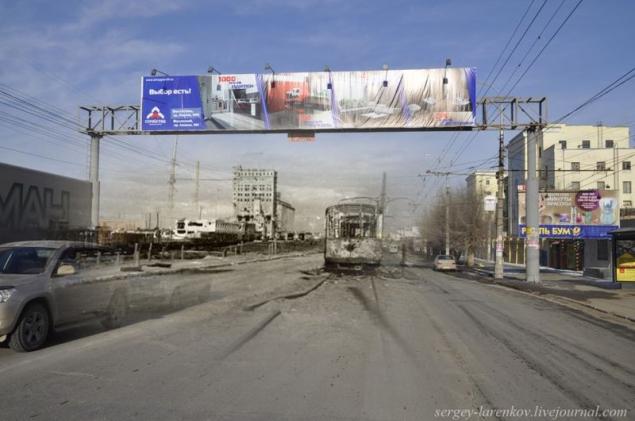
The building department store. Again the same point on the street. Ostrovsky in the courtyard of Intourist. It was here, in the basement, for the first time in the history of prisoner surrendered German Field Marshal.

Return to the city. Returning to the city residents were forced to live in the basements of destroyed buildings and dugouts in the shops restored enterprises.

St. Ogareva. Demining In the photo one of the surviving houses - House movers.

Department of the ruins of the hotel "Most of Stalingrad».

Department and the resurgent city

Berlin Reichstag 1945/2010.
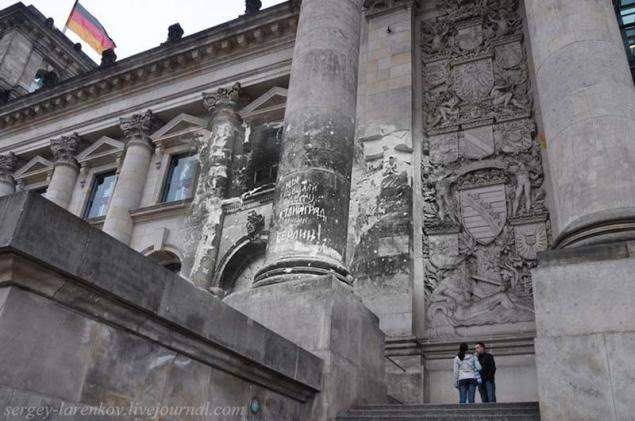
Fight near the elevator. Kozlovsky st., 65. Shot from German newsreels.
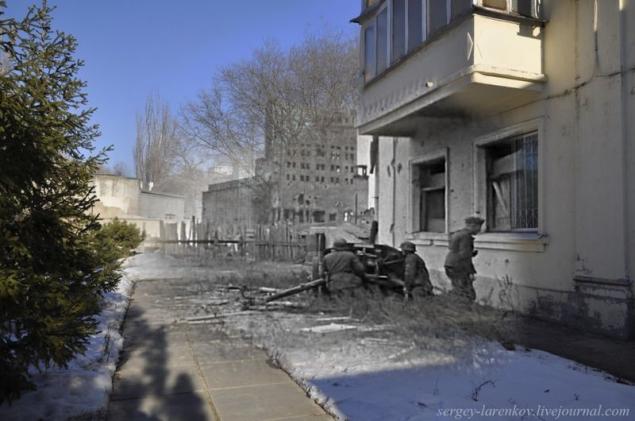
Elevator. On the walls of the elevator now you can easily see the scars of war.

After the battle on the Square of Fallen Fighters at the House of pilots. At the site of the House of pilots (left) is now building Volgograd State Medical University, connected with an arch-Hostess "Volgograd" right (too new building). A Pushkin Street between them remained.

Source: sergey-larenkov.livejournal.com

So, the summer of 1942. After a disaster, the Red Army near Kharkov in the front line to Don steppes exposed, and overcoming a few desperate resistance of the Soviet troops, the Wehrmacht launched an offensive to the Volga and the Caucasus. August 23 the Germans reached Stalingrad, on the same day the worst airstrike German bombers, who turned the once flourishing city in ruins solid. Within a few hours, killing more than 40 thousand inhabitants.

Obelisk on Fallen Fighters Square.
The Germans at Kursk Street. (St. Port Said) to the former school building (now the Engineering and Technical Lyceum) later was attached wing with a gym.

German guns in Musical Theatre. The theater building was rebuilt after the war, but greatly changed

Musical theater.

Paulus at Stalingrad tsenre Street. Ostrovsky. On the right is one of the few surviving pre-war buildings in part, now it is the hotel Old Stalingrad.

Paulus at department stores. The same place on the other side only. Behind yet Colonel-General Paulus same Department, who will go down in history associated with his name.

The building department with Hitler's flag. The facade of the department store located in the courtyard of the new building Intourist.

The soldiers of the Wehrmacht in the Kursk Street (now st. Port Said). Building on the left (Port Said 8a) did not seem to have changed.

Pavlov's House became a symbol of the defense of Stalingrad. In September 1942, the assault force under the command of Sergeant Yakov Pavlov knocked the Germans out of the building. Soviet soldiers kept house, repulsing the attacks of the Nazis for two months until the liquidation of the German group. Field Marshal Paulus on the first interrogation after capture admitted that attempts to capture the house on the square of the 9th January Germany lost more of their soldiers than the conquest of France.

Pavlov's House from the area on January 9 (Lenin Square). After the war, the House of Pavlov built a colonnade. In the background you can see the mill building Gerhardt.

Pavlov (the hero of the famous defense "Pavlov's House") and AM Cherkasova - Brigadier 1st Brigade volunteer to restore Stalingrad talk against the backdrop of the House of Pavlov Pavlov's House became one of the first buildings in Stalingrad recovery record. Now this is an ordinary house. When I shot it, granny angrily slid the curtain.

The angle of the hotel "Most of Stalingrad" and the building department. Prior to the airstrike. Both of these buildings and that from them will be visible in many of the photos. After the war, restored the building department in the basement where the headquarters of Paulus, will be built Intourist, but we'll get to that later.

Unpreserved inscriptions on the wall of the house Pavlova.

One of unpreserved inscriptions on the wall of Pavlov. No inscriptions on the house has been preserved, but at both ends to attach monumental brick inserts.

Sarepta. St. Arsenyev 6. This house is located in the southern part of the city, where German is not reached. But traces of destruction on the house allocated under modern paint.

Fight off the destroyed building of the hotel "Most of Stalingrad." There is a building already destroyed more than a photo № 05. Part of the old Tsaritsyn - Stalingrad had prewar diagonal layout of the streets, after the war, instead of them struck the streets parallel and perpendicular to the Volga. First punched Street - Street of Peace takes on the photo to the right.

Soviet T-34 tanks at the station. Station also includes fighting was heavily damaged. After the war, in its place built a new station, bears little resemblance to the old.

Soldiers at the Museum of Defense of Tsaritsyn at the end of the fighting. Now called Volgograd Memorial and Historical Museum, there is a very interesting exhibition dedicated to the Civil War, and white, and red. And behind the fighters is a monument to the legendary Cossack Konstantin I. Nedorubovu full of George Knight and hero of the Soviet Union. Behind you can see the station building.

The museum building after the fighting. The museum building was severely damaged during the fighting, but was rebuilt in its present form.

Stalin monument at the Museum of Defense of Tsaritsyn and communal house.

Communal house.

The ruins of houses with communal street. Gogol.

German gun is firing positions in the elevator. Building elevator is the highest in the city, and it turned fierce fighting. Stalingrad elevator defended seamen.

Soviet soldiers on Communist Street. Left - Ruined house communal and away surviving building at Communist, 10

Fountain "Children's dance" at Railway Square. At the site of the fountain is now parking.

Railway Station Square. Fountain "Children's dance." This photo Emmanuel Yevzerikhin is the most famous photograph taken in Stalingrad fight.

Fountain "Children's dance" on the background of the Museum of Defense. The fountain itself is a model in several cities in the Soviet Union were built exactly the same (Voronezh, Dnepropetrovsk).

Fountain "Children's dance." The fountain was rebuilt after the war, but in the 50 years analyzed as non-artistic value.

Fountain "Children's dance." Judging by the Volgograd press from time to time there is a question about the restoration of the fountain, but so far more than talk is not moved.

Dzerzhinsky Square. T-34 tank at Stalingrad Tractor Plant in front of the school №3. Exactly the same tank, and maybe this is worth here on the left as a monument.

Dug in the school yard №3. Tragic fate of the civilian population of Stalingrad. Of those who survived the bombing, many do not have time to evacuate, they had to live almost on the front line in the cellars and dugouts. On the German-occupied territory of civilians are being evicted and stolen in Germany.

T-34 tank on the Square of Fallen Fighters. Again, helped bind the building department, shines through the hotel "Intourist».

Beketovka. Paulus after the surrender before the first interrogation at the headquarters of the 64th Army. January 30 Hitler Paulus was awarded the rank of Field Marshal. Radiogram to this order has been accepted as to the headquarters of Paulus in the department store has approached the Soviet assault group. Hitler hoped that Paulus in this case prefer to shoot. However, this morning took delivery of Field Marshal captured. By 12 o'clock he was taken to the headquarters of Beketovku commander of the 64th Army, General Shumilova, where he hosted the first interrogation of Field Marshal. This is the place to find it was not so hard (harder to pass). In the distance you can see the building of the hospital, perfectly preserved since then. But upon closer inspection coincided home and on the right. Only they look older and a little rooted in the ground. 70 years all are gone.

German self-propelled guns at the Lipetsk Shturmgeshutts street.

Beketovka. Staff officers Paulus after surrender. In this house the headquarters of the commander of the 64th Army, General Shumilova what states corresponding to a memorial plaque, as well as the fact that it hosted the first interrogation of a German field marshal.

Red Army soldiers at the barricades on the Square of Fallen Fighters.

Fallen Fighters Square after the end of fighting.

Fallen Fighters Square after the end of fighting.

Area of Fallen Fighters. Surrendering the Nazis, survived the assault.

Shadows of the prisoners of the Nazis in the Square of Fallen Fighters. I think this corner of the hotel "Most of Stalingrad" is the same symbol photographic Battle of Stalingrad, as the fountain "Children's dance».

Captured Germans in the Square of the fallen fighters. In Stalingrad cauldron was captured more than 91 thousand German soldiers and officers, including 24 generals.

Captured Germans at the factory Red October. One of the three collapsed buildings left in Volgograd as a monument, located on the territory of the factory Red October. This two-story brick building, central laboratory. From this perspective it can be seen only the right end, the rest of the temple now covers. Well, on the collage all seen through the temple. I want to thank the Department of Public Relations factory "Red October", and personally Dametken Arshimovu and Veronica Yurkov for the operational organization of admission to the regime territory of the plant.

Captured soldiers of the German 6th Army at the elevator.

German graves at the department store.

Stalingrad 1942 - Volgograd, 2013. Street Ostrovsky. Refugee with things. Acute angle, the remainder of the hotel "Most of Stalingrad" allows a certain accuracy to calculate this place. All modern buildings built in the frame without reference to the foundation of the old, in new places.

German graves at the department store.

Captured on dismantling the ruins of the station. Return to Germany German prisoners began in 1945. Were first released disabled and the sick. By 1950, the majority of Germans who did not participate in war crimes to go home. Released the latest by 1955.

Destroyed mill Gerhardt and Panorama. It is often mistakenly referred to as the House of the mill Pavlova.

Kirch

Proletkultskaya street

Mamaev Kurgan after fighting


The meeting at the Square of Fallen Fighters after the defeat of the German group.

Gogol Street. Nail-building plant - still one of the few remaining after the war. Left, behind the fence, the Museum of Defense, and the same can be seen in front of the remaining corner of the hotel "Most of Stalingrad" and the area of Fallen Fighters.

Cartage I read somewhere that some part of the rear entrance to the camel carts in Berlin, it shocked Germans more than the Russian tanks.

Tram in the combat zone in the elevator to the Workers' and Peasants street.

The building department store. Again the same point on the street. Ostrovsky in the courtyard of Intourist. It was here, in the basement, for the first time in the history of prisoner surrendered German Field Marshal.

Return to the city. Returning to the city residents were forced to live in the basements of destroyed buildings and dugouts in the shops restored enterprises.

St. Ogareva. Demining In the photo one of the surviving houses - House movers.

Department of the ruins of the hotel "Most of Stalingrad».

Department and the resurgent city

Berlin Reichstag 1945/2010.

Fight near the elevator. Kozlovsky st., 65. Shot from German newsreels.

Elevator. On the walls of the elevator now you can easily see the scars of war.

After the battle on the Square of Fallen Fighters at the House of pilots. At the site of the House of pilots (left) is now building Volgograd State Medical University, connected with an arch-Hostess "Volgograd" right (too new building). A Pushkin Street between them remained.

Source: sergey-larenkov.livejournal.com
Tony Svotton equips Hollywood (8 photos)
How did you manage to insert a reactor in the chest by Tony Stark (5 photos)

